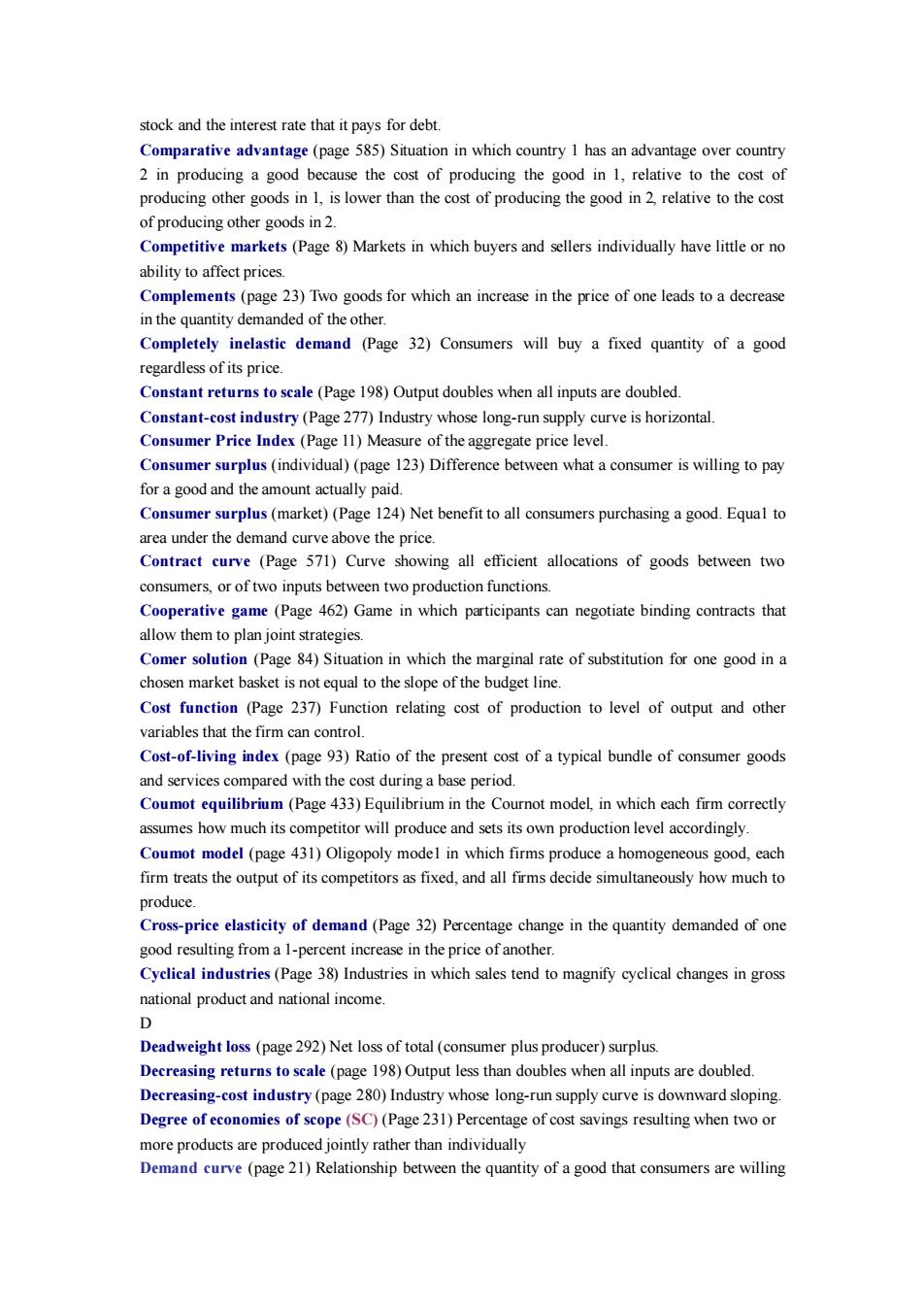正在加载图片...

stock and the interest rate that it pays for debt 2 in producing a good because the cost of producing the good in 1,relative to the cost of producing other goods in 1,is lower than the cost of producing the good in 2 relative to the cost of producing other goods in 2. Competitive markets(Page 8)Markets in which buvers and sellers individually have little or no abilityto affect pric Complements(page 23)Two goods for which an increase in the price of one leads to a decrease in the quantity demanded of the other. Completely inelastic demand (Page 32)Consumers will buy a fixed quantity of a good regardless of its price. Constant returns toseale (Page 198)Output doubles when all inputs are doubled. Constant-cost indu ry(Page 277)Industry whose long-run supply curve is horizontal Consumer Price Index(Page 11)Measure of the aggregate price level Consumer surplus (individual)(page 123)Difference between what a consumer is willing to pay for a good and the amount actually paid. Consumer surplus(market)(Page 124)Net benefit to all consumers purchasing a good.Equal to area under the e the Contract curve (Page 571)Curve showing all efficient allocations of goods between two consumers,or of two inputs between two production functions. Cooperative game(Page 462)Game in which participants can negotiate binding contracts that allow them to plan joint strategies. Comer solution (Page8)Situation in which the al rate of substitution for one good in a osen market basket Cost function (Page 237)Function relating cost of production to level of output and other variables that the firm can control Cost-of-living index (page 93)Ratio of the present cost of a typical bundle of consumer goods nd services npared with the cs duringa base period. Coumot equili此 m(Page 433)Equilit ium in the Co ourot model,in which each firm assumes how much its competitor will produce and sets its own production level accordingly. Coumot model (page 431)Oligopoly model in which firms produce a homogeneous good.each firm treats the output of its competitors as fixed,and all firms decide simultaneously how much to produce. Cross-price elasticity of demand (Page 32)Percentage change in the quantity demanded ofone good resul ting from a I-percent increase in the price of anothe Cyclical industries(Page 38)Industries in which sales tend to magnify cyclical changes in gross national product and national income. D Decreasing return Decreasing-cost industry (page 280)Industry whose long-run supply curve is downward sloping Degree of economies of scope(SC)(Page 231)Percentage of cost savings resulting when two or more products are produced jointly rather than individually Demand crve (page21)Relationship between the quantity of a good that consumers are willingstock and the interest rate that it pays for debt. Comparative advantage (page 585) Situation in which country 1 has an advantage over country 2 in producing a good because the cost of producing the good in 1, relative to the cost of producing other goods in 1, is lower than the cost of producing the good in 2, relative to the cost of producing other goods in 2. Competitive markets (Page 8) Markets in which buyers and sellers individually have little or no ability to affect prices. Complements (page 23) Two goods for which an increase in the price of one leads to a decrease in the quantity demanded of the other. Completely inelastic demand (Page 32) Consumers will buy a fixed quantity of a good regardless of its price. Constant returns to scale (Page 198) Output doubles when all inputs are doubled. Constant-cost industry (Page 277) Industry whose long-run supply curve is horizontal. Consumer Price Index (Page 11) Measure of the aggregate price level. Consumer surplus (individual) (page 123) Difference between what a consumer is willing to pay for a good and the amount actually paid. Consumer surplus (market) (Page 124) Net benefit to all consumers purchasing a good. Equa1 to area under the demand curve above the price. Contract curve (Page 571) Curve showing all efficient allocations of goods between two consumers, or of two inputs between two production functions. Cooperative game (Page 462) Game in which participants can negotiate binding contracts that allow them to plan joint strategies. Comer solution (Page 84) Situation in which the marginal rate of substitution for one good in a chosen market basket is not equal to the slope of the budget line. Cost function (Page 237) Function relating cost of production to level of output and other variables that the firm can control. Cost-of-living index (page 93) Ratio of the present cost of a typical bundle of consumer goods and services compared with the cost during a base period. Coumot equilibrium (Page 433) Equilibrium in the Cournot model, in which each firm correctly assumes how much its competitor will produce and sets its own production level accordingly. Coumot model (page 431) Oligopoly mode1 in which firms produce a homogeneous good, each firm treats the output of its competitors as fixed, and all firms decide simultaneously how much to produce. Cross-price elasticity of demand (Page 32) Percentage change in the quantity demanded of one good resulting from a 1-percent increase in the price of another. Cyclical industries (Page 38) Industries in which sales tend to magnify cyclical changes in gross national product and national income. D Deadweight loss (page 292) Net loss of total (consumer plus producer) surplus. Decreasing returns to scale (page 198) Output less than doubles when all inputs are doubled. Decreasing-cost industry (page 280) Industry whose long-run supply curve is downward sloping. Degree of economies of scope (SC) (Page 231) Percentage of cost savings resulting when two or more products are produced jointly rather than individually Demand curve (page 21) Relationship between the quantity of a good that consumers are willing